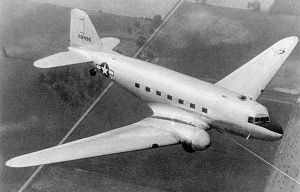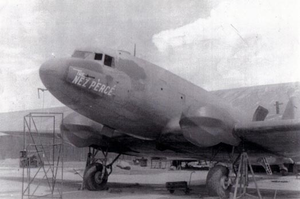- Douglas XCG-17
-
XCG-17 The XCG-17 during towed flight Role Assault glider Manufacturer Douglas Aircraft First flight June 14, 1944 Primary user United States Army Air Forces Number built 1 Developed from Douglas C-47 Skytrain Type Prototype Construction number 4588 Registration N69030
XA-JID
XC-0PSSerial 41-18496 The Douglas XCG-17 was an American assault glider, developed by the conversion of a C-47 Skytrain twin-engine transport during World War II. Although the XCG-17 was successful in testing, the requirement for such a large glider had passed, and no further examples of the type were built; one additional C-47, however, was converted in the field to glider configuration briefly during 1946 for evaluation, but was quickly reconverted to powered configuration.
Contents
Design and development
With the introduction of the Douglas C-54 Skymaster four-engined transport aircraft, the United States Army Air Forces, observing that conventional gliders then in service[N 1] would be an inefficient use of the C-54's power and capacity, determined that a requirement existed for a new, much larger assault glider.[2][3] It was determined that the best solution to the requirement was the conversion of the Douglas C-47 Skytrain, already in large-scale production, to meet the requirement. The C-47 could be converted to a glider configuration with minimal alteration to the airframe, and would provide the required capacity.[3]
Trials conducted using a conventional, powered C-47, first conducting ordinary deadstick landings, then being towed by another C-47, indicated that the scheme was feasible.[2] Therefore a C-47-DL was taken in hand for conversion into a glider, which was given the designation XCG-17.[4][5][N 2] The aircraft, formerly a Northwest Airlines DC-3 that had been impressed into military service at the start of World War II,[7][N 3] was modified by the removal of the aircraft's engines; the nacelles, containing the landing gear, remained in place, covered with aerodynamically profiled hemispherical domes for streamlining, containing fixed weight to compensate for the removal of the engines.[3][7][9] Other equipment, no longer necessary with the conversion to an unpowered configuration, was also removed to save weight;[3] items removed included the aircraft's wiring and bulkheads, along with the navigator's and radio operator's positions.[1][7]
Operational history
The conversion, carried out at Clinton County Army Air Field, was completed on June 12, 1944, with the aircraft undergoing its initial flight test shortly thereafter.[7] The flight testing of the XCG-17 proved that the aircraft was satisfactory; compared to conventional gliders in service, the aircraft possessed lower stalling and higher towing speeds than conventional gliders, as well as gliding at a significantly shallower angle.[4][10] Tow tests were conducted using a variety of aircraft; the most commonly used configuration was a tandem tow by two C-47s, with the towing aircraft coupled in tandem and the leading aircraft detaching following takeoff.[3] This configuration was dangerous for the "middle" C-47, however,[7] and it was determined that a single C-54 was the optimal tug aircraft.[2][7]
The XCG-17's cargo hold had a capacity of 15,000 pounds (6,800 kg);[1][7][9] alternatively, up to 40 fully equipped troops could be transported, these figures being significantly larger than conventional gliders' capacity.[3] The XCG-17 was also capable of carrying three jeeps in a single load, or alternatively two 105-millimetre (4.1 in) howitzers.[7] Regardless of the aircraft's load, no ballast was required to maintain the aircraft's center of gravity,[3] a trait unique among American assault gliders.[7]
Despite the satisfactory results in testing, however, the aircraft failed the Army's requirement that it be capable of landing on unimproved fields;[7] in addition, by the time the evaluation of the XCG-17 was completed the need for such a large assault glider had passed.[1][9] The primary role for the glider had been intended to increase the amount of supplies that could be carried to China over "The Hump"; the war situation had, however, become more favorable and the added capacity an oversized glider would provide was no longer required.[11] No further examples of the type were produced; the prototype, its trials complete, was placed in storage, being ferried to Davis-Monthan Air Force Base for disposal in August 1946.[7]
In August 1949, the aircraft was sold to Advance Industries, its engines being reinstalled to return the aircraft to powered status in DC-3C configuration.[7] Some sources, however, indicate that the XCG-17 was re-converted to C-47 configuration in 1946.[9] Following its restoration to powered status, the aircraft was transferred to Mexico,[7] where it remained in civilian service until 1980.[12]
Field conversion
"Nez Perce" "Nez Perce" after conversion to glider configuration Other name(s) XCG-47; XCG-17 Type Field converted glider Manufactured 1946 Serial 43-16229 First flight June 17, 1946 (as glider) Fate Reconverted to C-47 Although the XCG-17 failed to lead to any production of a C-47 derived glider type, a single C-47 was converted in the field to a glider configuration by the Fifth Air Service Area Command, located at Nichols Field on Luzon in the Philippines, during January 1946.[7] Carried out in much the same manner as the XCG-17, the conversion included octagonally shaped fairings over the engine mountings, with an auxiliary power unit from a B-24 Liberator bomber being installed.[7]
Referred to as "XCG-47" as well as "XCG-17", and named "Nez Perce",[7] the aircraft undertook its initial flight following conversion on June 17, 1946, towed by a C-54.[7] The flight tests of the field-converted aircraft proved favourable, and an ambitious flight, towing the aircraft from Luzon to Tokyo in Japan, was planned.[7] This flight was intended to prove the suitability of large gliders to act as an "aerial freight train" for regular transport.[7]
The flight, conducted in late June 1946, took 11 hours of flight time and included an overnight stay on Okinawa; covering 1,800 miles (2,900 km), it concluded at Tachikawa Airfield near Tokyo.[7] Despite the success of the flight, the "aerial freight train" concept did not catch on; the aircraft had its engines re-fitted in August 1946 and was returned to service as a normal C-47.[7]
Operators
Military (as C-47, then XCG-17)
Civilian (as DC-3C)
- Petroleos Mexicanos[12]
Specifications (41-18496)
General characteristics
- Crew: Two (Pilot and copilot)
- Capacity: 15,000 pounds (6,800 kg) cargo or 40 troops
- Length: 63 ft 9 in (19.43 m)
- Wingspan: 95 ft 6 in (29.11 m)
- Height: 17 ft (5.2 m)
- Wing area: 987 sq ft (91.7 m2)
- Empty weight: 11,001 lb (4,990 kg)
- Gross weight: 26,000 lb (11,793 kg)
Performance
- Maximum speed: 290 mph (470 km/h; 250 kn) max towing speed
- Cruising speed: 190 mph; 165 kn (305 km/h) gliding speed
- Stall speed: 35 mph (30 kn; 56 km/h)
- Maximum glide ratio: 14:1
- Wing loading: 26.3 lb/sq ft (128 kg/m²)
See also
- Related development
- Douglas DC-3
- Douglas C-47 Skytrain
- Douglas AC-47 Spooky
- Douglas C-53 Skytrooper
- Lisunov Li-2
- Showa L2D
- Aircraft of comparable role, configuration and era
- Chase XCG-20
- General Aircraft Hamilcar
- Ilyushin Il-32
- Messerschmitt Me 321
- Related lists
References
- Notes
- ^ The Waco CG-4 was the glider most commonly used by the USAAF during World War II.[1]
- ^ In the U.S. Army Air Forces' designation scheme, the "-DL" suffix indicated an aircraft built at Douglas' Long Beach, California factory.[6]
- ^ A variety of DC-3 series aircraft were impressed into military service at the start of the war. While DC-3 series aircraft constructed for the military were given the designation C-47, impressed aircraft received a variety of designations, including C-47, C-48, C-49, C-50 and C-53, among others. Confusing things further is that the C-53 designation was also assigned to purpose-built military DC-3s, named Skytrooper, that were intended exclusively for personnel transport.[8]
- Citations
- ^ a b c d Nigl and Nigl 2007, pp.16-17.
- ^ a b c Swanborough and Bowers 1989, p.274.
- ^ a b c d e f g h Taylor 1991, p.151.
- ^ a b Francillon 1988, p.233.
- ^ Davis 1995, p.40.
- ^ Bowers 1986, p.85.
- ^ a b c d e f g h i j k l m n o p q r s t u Day 2001
- ^ Davis 1995, p.31.
- ^ a b c d Grim 2009, p.17.
- ^ Serling 1997, p.62.
- ^ a b "XCG-17" (in Russian). Airwar.ru. http://www.airwar.ru/enc/glider/xcg17.html. Retrieved 2011-01-20.
- ^ a b Baugher 2010
- ^ Francillon 1988
- Bibliography
- Baugher, Joe (July 18, 2010). "1941 USAAF Serial Numbers (41-13297 to 41-24339)". USAAS-USAAC-USAAF-USAF Aircraft Serial Numbers--1908 to Present. http://www.joebaugher.com/usaf_serials/1941_3.html. Retrieved 2011-01-21.
- Bowers, Peter M. (1986). The DC-3: 50 Years of Legendary Flight. Fallbrook, CA: Aero Publishers. ISBN 978-0830681945. http://books.google.com/books?ei=_Nk5TeusGsH68AbXmODJCg&ct=result&id=yKdTAAAAMAAJ&dq=%22C-47-DL%22+%22DC-3C%22&q=%22C-47-DL%22#search_anchor. Retrieved 2011-01-21.
- Davis, Larry (1995). C-47 Skytrain in action. Aircraft In Action. 149. Carrollton, TX: Squadron/Signal Publications. ISBN 0-89747-329-0.
- Day, Charles L. (2001). "The XCG-17 Glider". Research conducted for Silent Ones: WWII Invasion Glider Test and Experiment, Clinton County Army Air Field, Wilmingon, Ohio. Lubbock, TX: Silent Wings Museum. http://silentwings.ci.lubbock.tx.us/images/Web%20Content/The%20XCG17_Gliders_Pics.doc.pdf. Retrieved 2011-01-20.
- Francillon, René J. (1988). McDonnell Douglas Aircraft since 1920. 1. Kirkwood, NY: Putnam Publishing. ISBN 978-0851778273. http://books.google.com/books?id=QEe6WUHADJ8C.
- Grim, J. Norman (2009). To Fly the Gentle Giants: The Training of U.S. WW II Glider Pilots. Bloomington, IN: AuthorHouse. ISBN 978-1-4389-0485-6. http://books.google.com/books?id=q2-TnqzXt0sC&pg=PA313. Retrieved 2011-01-20.
- Nigl, Alfred J.; Charles A. Nigl (2007). Silent Wings Savage Death. Santa Ana, CA: Graphic Publishers. ISBN 1-882824-31-8. http://books.google.com/books?id=iHlI6P5lPkUC&pg=PA16. Retrieved 2011-01-21.
- Serling, Robert J. (1997). When the Airlines Went to War. New York: Kensington Books. ISBN 978-1575662466. http://books.google.com/books?ei=gYE3TZmLF8b_lgeur7DXBg&ct=result&id=93jxAAAAMAAJ&dq=Douglas+%22XCG-17%22&q=%22XCG-17%22#search_anchor.
- Swanborough, Gordon; Peter M. Bowers (1989). United States Military Aircraft since 1909. Washington, D.C.: Smithsonian Institution Press. ISBN 978-0874748802. http://books.google.com/books?id=TIffAAAAMAAJ&q=Douglas+%22XCG-17%22&dq=Douglas+%22XCG-17%22&hl=en&ei=gYE3TZmLF8b_lgeur7DXBg&sa=X&oi=book_result&ct=result&resnum=3&ved=0CCoQ6AEwAjgK.
- Taylor, Michael J.H., ed (1991). Jane's American Fighting Aircraft of the 20th Century. New York: Mallard Press. ISBN 0-7924-5627-0. http://books.google.com/books?id=MZGRVCAPLjYC.
External links
 Media related to Douglas XCG-17 at Wikimedia Commons
Media related to Douglas XCG-17 at Wikimedia CommonsUSAAC/USAAF glider aircraft designations Assault Glider AG-1 • AG-2
Bomb Glider Cargo Glider Fuel Glider Powered Glider Training Glider Douglas military aircraft Fighters Ground attack Naval bombers
and attack aircraftBombers Observation Patrol PD · P2D · P3D
Reconnaisance Transports C-1 · C-21 · C-32 · C-33 · YC-34 · C-38 · C-39 · C-41 · C-41A · C-42 · C-47 · C-48 · C-49 · C-50 · C-51 · C-52 · C-53 · C-54 · C-58 · UC-67 · C-68 · C-74 · C-84 · C-110 · XC-112/YC-112 · XC-114 · YC-116 · C-117 · C-118 · C-124 · YC-129 · C-133 · XCG-17
C-9 · C-24
RD · R2D · R3D · R4D (R4D-2 & R4D-4) · R5D · JD · R6D
CC-129 · Dakota I/III/IV · Dakota II · LXD1 · PD.808 · Skymaster ITraining aircraft Experimental Lists relating to aviation General Aircraft (manufacturers) · Aircraft engines (manufacturers) · Airlines (defunct) · Airports · Civil authorities · Museums · Registration prefixes · Rotorcraft (manufacturers) · TimelineMilitary Accidents/incidents Records Categories:- Douglas aircraft
- United States military gliders 1940–1949
- United States military transport aircraft 1940–1949
Wikimedia Foundation. 2010.



